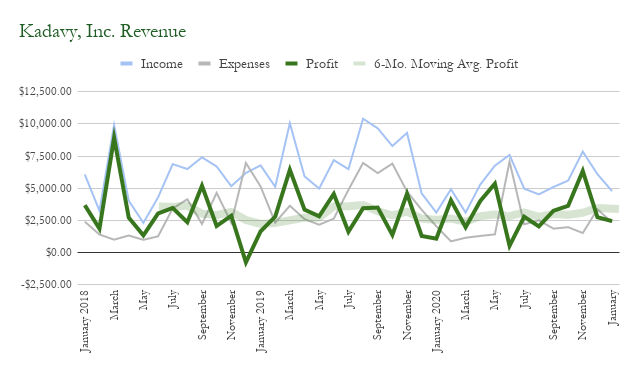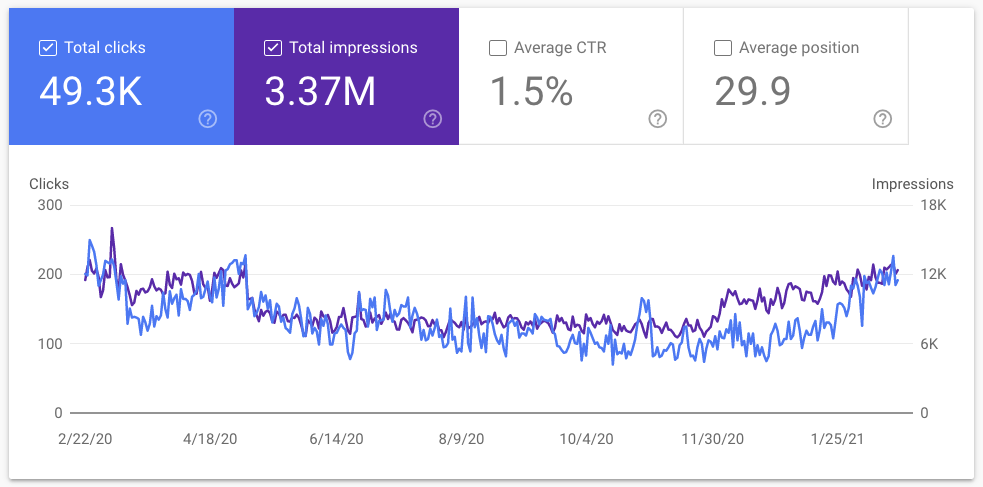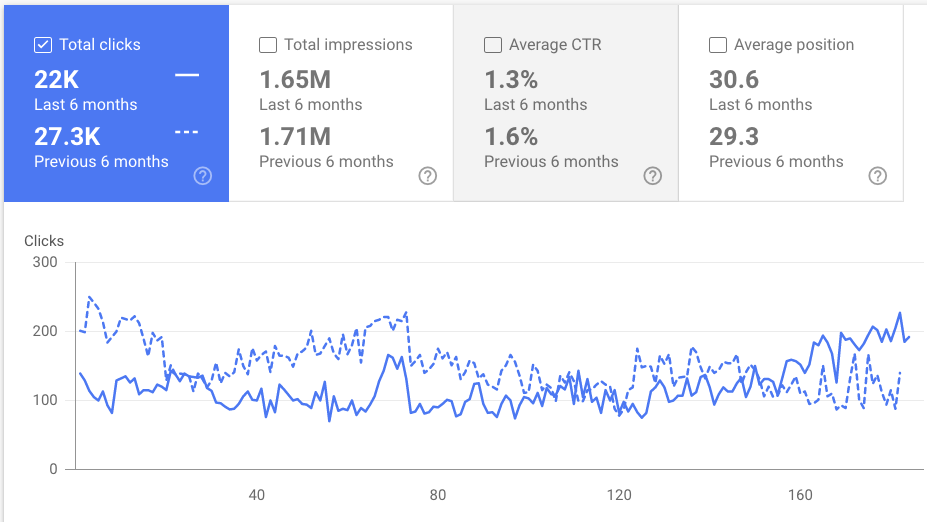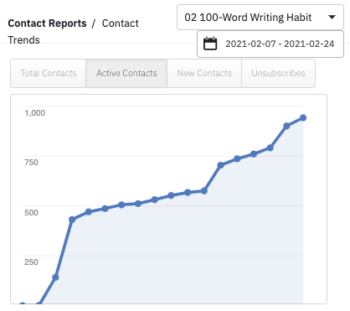Subscribe to blog updates via email »
January 2021 Income Report
An audio version of this income report is available to Patreon backers of certain levels »
January’s revenues were $4,772, down from December’s $6,090. Profits were $2,436, down from December’s $2,738.


WANT TO WRITE A BOOK?
Download your FREE copy of How to Write a Book »
(for a limited time)
January was a below-average profit month, which would look much worse if it wasn’t for the change in accounting methods. As mentioned in last month’s report, I’m now amortizing big yearly payments into monthly expenses. In January, I paid more than $1,150 to WP Engine for a year of hosting. That breaks down to only $96 for this month.
Then again, this amortization not only makes the months in which these big payments took place look more profitable than they actually were, it also causes a number of expenses to show up each month that before were not showing up. The $135 payment to ActiveCampaign that now shows up in each month’s report is one example.
Ulysses and Drafts expenses showing up monthly
After spending several months redesigning my note-taking workflow, I’ve settled in on using both Ulysses and Drafts regularly. Ulysses is $6.99 a month, and Drafts is $1.99 a month.
I originally liked Ulysses for managing my Zettelkasten (note-taking system), mostly because you can preview the contents of many files at once. It also has a decent workflow for managing tags. However, I have started using Obsidian more frequently for managing my Zettelkasten on desktop. I do lots of plain-text note-taking and writing on 1Writer for iPad.
Even though I use Ulysses very little for managing my Zettelkasten, and I do most writing on 1Writer on my iPad, it’s still hard to beat Ulysses for publishing to WordPress. After I write an initial draft of a blog post – such as these reports – I put on the finishing touches on Ulysses on my computer, including adding images. It then exports to WordPress, images and all. It supports Markdown and I prefer writing in Markdown. All this saves enough time and energy to be worth $6.99 a month.
Drafts is great for quick capture of ideas. I sometimes manage a quick and small project entirely in Drafts. I also use it as an inbox-before-the-inbox for my Zettelkasten. This is worth $1.99 a month.
Evernote yearly payment
I did this month pay $35 for Evernote. I still use it for project management and documenting my operations on desktop. It has gotten worse and worse over the years, and I dread opening the app on my phone, knowing what should take a few seconds to capture will likely end up taking several minutes of frustration.
I would not be using Evernote if I didn’t already have so many notes in there from a decade of use. I do not recommend it.
Even though that $35 is for one year, I’m not amortizing it. I suppose I should be paying for a year up-front for both Ulysses and Drafts, but I’ll wait until my new workflow has solidified. It’s also better to do yearly expenses toward the end of the year.
SEO focus paying off?
It has now been five months since – in August’s report – I decided to start thinking about SEO again. In choosing topics to write about, I had been ignoring the possibilities of inbound search traffic for years – aside from my successful affiliate-revenue-drivers such as my ActiveCampaign review.
Since then, I have chosen topics and optimized a number of posts based upon potential search traffic, while trying to take a barbell strategy for content marketing approach. My first podcast episode in which I took this approach was my Getting Things Done book summary in mid-October. I’ve also written some author-targeted content in shorter posts such as my Kindle Daily Deals experience, which came out in late September.
Google Search Console on an upward trend
At first glance of Google Search Console, it looks like my SEO-content efforts are paying off. Inbound clicks are on an upward trend over the past three months.

However, looking closer at the data, it’s not totally clear this is due to my change in content approach.
U-shaped over the past year
Inbound clicks make a U-shaped graph over the past year. This recent upward tick merely has me bringing in about as much traffic as I was a year ago.

Why was there such a drop in the middle? Let’s see what happens when I compare the past 6 months to the previous 6 months.

When I look at which terms have the biggest increase in inbound clicks over the past 6 months, they’re mostly for content I’ve had for years. The most relevant terms are about alphasmart. I’m also seeing an increase in body by science-related terms, which isn’t terribly relevant.
“David Kadavy” searches up 20%
One highlight is that “branded” terms – in other words, people searching for “david kadavy” are up 20% over the past 6 months, versus the previous period. That’s one of my top-growing search terms – though that may be temporary and due to launching a new book.
Only one hit term from my efforts so far
The only term I see from my recent SEO efforts, in the top 50-growing terms in the past 6 months, is kindle daily deal. That article has brought 84 inbound clicks.
That is not a ton and I’m tempted to say at least it’s relevant (authors), but the term is literally just “kindle daily deal.” So it’s likely I’m just bringing in searches from book shoppers looking for the latest Kindle Daily Deal, and they’re ending up on my site. I could say that was relevant since they are book shoppers, but I don’t know if it’s leading to any sales.
Declining search terms
What about search terms that are bringing in less traffic? I’m pleased to see at the top of that list some spectacularly irrelevant keywords such as those related to my mucocele post, and keywords about my federal court jury duty experience.
However, I’m also seeing a drop in some golden goose keywords such as “activecamaign review”. I shouldn’t be surprised. My review is getting old.
Then there are some writing-related keywords such as how to write a book – which has proven to be very competitive!
Oddly, there are also drops in keywords related to topics where I saw increases, such as those related to my AlphaSmart, and Body by Science.
Search performance for recent SEO-content
What’s getting lost in this review of the top search terms is whether I’m seeing any traffic at all from the recent posts I’ve written in the hopes of attracting relevant inbound search traffic. I can get a clearer picture of that by seeing the data for those posts, one at a time.
Here are the numbers so far, in order of release date:
- Kindle Daily Deals: 260 clicks / 144k impressions
- Getting Things Done book summary: 10 clicks / 3.35k impressions
- IngramSpark hardcover review: 95 clicks / 4.91k impressions
- The Black Swan book summary: 9 clicks / 2.86k impressions
- Advance reader copies: IngramSpark vs. KDP Print vs. Barnes & Noble Press: 52 clicks / 2.63k impressions
- Amazon Great on Kindle experience: 5 clicks / 556 impressions
- Naval Ravikant meditation: 11 clicks / 144 impressions
- Land a BookBub Featured Deal: 7 clicks / 1.06k impressions
- BookBub Featured New Release: 0 clicks/impressions (not showing up – Google seems to be confusing it with the above BookBub post)
- Understanding Media book summary: 0 clicks / 34 impressions
I’ve also created some WordPress “pages” published outside the main blog feed:
- Best Productivity Books: 3 clicks / 3.29k impressions
- Best Creativity Books: 2 clicks / 1.17k impressions
Finally, I’ve created some dedicated landing pages for my self-published books:
- The Heart to Start: 1 click / 103 impressions
- Mind Management, Not Time Management: 19 clicks / 792 impressions
I also experimented with publishing my notes from a meta-analysis I read, is ego depletion real?. That doesn’t show up in Search Console.
How does that compare to non-SEO articles?
This closer look does tell us that some traffic is coming in for these SEO-focused articles. But how does that compare to articles that aren’t SEO-focused?
- Complexity Creep & The Birthday Problem: 7 clicks / 1.29k impressions
- Shun the Unearned: 2 clicks / 305 impressions
- Week of Want: 1 click / 418 impressions
- Welcome to the Creative Age: 7 clicks / 600 impressions
- Raised Floors: 0 clicks / 293 impressions
- The Avocado Challenge: 12 clicks / 801 impressions
SEO articles attract more Google clicks than non-SEO articles
Just eyeballing this sample as compared to the SEO-focused articles, it looks like I get more inbound search clicks when I write with SEO in mind (surprise, surprise!) The SEO-focused articles averaged 34 clicks. The other articles averaged 5.
The non-SEO-focused articles also mostly have the benefit of time. All except “The Avocado Challenge” were published before I started writing SEO-focused articles, so have had more time to accumulate clicks. (It’s interesting “The Avocado Challenge” leads this pack. It actually has recent inbound searches for “avocado challenge” – maybe the idea will catch on!) Another thing that makes the SEO-focused articles look even stronger is the two most-recent SEO-focused articles have no clicks at all. I think they’re too new. The average would be higher without those.
Is this good?
So SEO articles bring in more clicks than non-SEO articles. Is that good? Obviously more clicks is better than fewer clicks, but what other considerations are there?
Many of these SEO articles are podcast episodes. I was going to be writing an article anyway, and it doesn’t appear that choosing SEO topics reduced subscriber downloads – at least in the short term. In this way, I got more marginal benefit from writing SEO content than if I had written whatever I felt like.
One could argue that my non-SEO articles are better because they showcase my own ideas – whereas the SEO articles are mostly summaries of books, or documentation of my experiences. My counter to that would be that many of these articles still contain my ideas. They either showcase my own thinking related to these existing ideas, or I link to my non-SEO articles from these SEO articles. Additionally, by studying these books more closely, I think I am planting seeds for better personal ideas in the future. The fact that these personal ideas link to existing ideas gives my ideas a potential route to being discovered – those already searching for the ideas which will link to my personal ideas. Finally, I’m in a transitional stage after completing a book. A cycle I may follow is to document existing ideas for a period, then share my personal ideas that spawn from those for a period, then release a book.
So much work, so little traffic
What’s remarkable about looking over these numbers is how much work it was to get so little traffic. Back when I could easily get an article on the front page of Hacker News, it wasn’t unusual to get 20,000 or 30,000 views of a single article in a few days. All of these SEO articles combined have brought no more than 500 clicks from Google!
Of course, these are two different kinds of traffic. Someone scanning a news site and clicking through to an article for a few seconds is far different from someone looking for very specific information and finding it.
What is good and what is bad?
So there are many shades of gray to evaluate these results. I can say that writing SEO-focused articles brings more search traffic than writing non-SEO articles. But is that improvement enough to grow my business?
This leads me to an age-old problem in my business: What is success? I don’t have a flagship course I’m selling. I like to get affiliate revenue from posts such as my ActiveCampaign review, but it’s not my main focus. Mostly I want to sell books, but the per-unit profit is pretty small and it’s hard to track whether traffic to one of these posts led to any book sales.
I’m tempted to say the best thing for me to go for is email subscribers. Get new people on my email list so that when I sell a book or even a course, I have a direct line.
What’s worth measuring?
Since I’m trying to wean myself off Google Analytics and rely instead on Fathom, I’m not even sure, technically, how I would track the success of articles converting to email sign ups. It’s something I could look into, but honestly even thinking about it makes me bored.
It returns me back to an idea I’ve been thinking about lately of the “black box” in online marketing. That if all you do is try to move the needle on some key metric such as sales or email sign-ups, well, everyone else is doing that, too. And that will make your work like everyone else’s. And that will make your work suck.
The strategy this leads me to is unsatisfying to some: Just get people engaged with your content – relevant content that you believe in – and the rest will work itself out. The real magic happens in the “black box” – how your work makes someone think and talk when they aren’t on your website.
Predicting article SEO performance
What’s worth writing about and what is not? I don’t have a clear answer to that question, but I’m gaining some clarity with PredictionBook. Before I publish an article, I predict how many clicks it will get in Search Console over a period of time. When that period of time is up, I rate my prediction (which calculates a Brier score like in the Avocado Challenge).
For example, I predicted my IngramSpark Hardcover post would get twenty or more clicks within three months of publish – it did. I predicted my Black Swan book summary would get the same – it did not. I was 30% confident in my IngramSpark prediction, and only 10% confident in my Black Swan prediction, so there’s some indication I have a sense of reality.
SEO content can take a looong time to mature. So, I also have predictions set up for one year after publish. I’m just getting started making such predictions, and I don’t have a formal model for making them, other than looking at some search volume data and making a guess. Perhaps I’ll get better at making these predictions over time – if I can keep up the discipline of actually making and rating them.
Growth potential for SEO articles
Since SEO content can take so long to mature, there is still a lot of growth potential for articles I have written so far. For example, my Black Swan book summary ranks twenty-eight for “the black swan book summary.” My Getting Things Done summary ranks twentieth for “getting things done summary.” Neither of these have any clicks for these respective terms.
If these articles ranked on the first page, they would get more clicks. I’m not doing any link-building for these articles, nor any promotion aside from my blog updates email list and Twitter.
In my experience, simply waiting often brings better results. It’s possible I might try link-building, too – though it’s not a way I’d like to spend my energy.
For some upcoming articles, I’m predicting how confident I am I can rank an article in the top ten for a given keyword. In addition to that, I may want to make conditional predictions about how many clicks I would expect to attract if I am able to rank in the top ten.
Forward march
After thinking of all this I don’t have a plan to change my strategy. I still want to think about SEO as I consider what to write about – of course also considering what is interesting to me. I do hope to keep making and rating predictions about the content I choose to write about.
New (free) email course: 100-Word Writing Habit
I’ve launched a new (free) email course. 100-Word Writing Habit starts March 3rd.
The idea for this course came in kind of a flash of inspiration. Since agonizing over whether or not to change email marketing platforms, I’ve been thinking more about email marketing in general. As I was waking up one morning, I was thinking I needed some kind of evergreen lead-generation. My Design Pitfalls course works as a nice little flywheel for bringing in Design for Hackers leads, and Summer of Design is one of my biggest breakthroughs ever. In fact, the formula I used for it is one of my courses, Explosive Email Course. But I don’t have something similar for my creative productivity content. (I do have Summer of Starting, but it’s not very widely appealing.)
A eureka moment
I got it in my head that I should have a course for how to build a writing habit. So, first thing that morning I brainstormed a course. Then, I started thinking it needs to be more specific than just build a writing habit. I realized I’m a big fan of tiny habits – that I’ve dabbled in writing 100-word blog posts, and I still write 100 words first thing in the morning on my AlphaSmart.
I spent my entire Friday brainstorming the course, and repurposing my Summer of Design landing page code to build a landing page. I spent the following Monday putting on the finishing touches, and launched it the next day, on a Tuesday. So far, there are nearly 1,000 people enrolled, and many of them are brand-new subscribers:

Following my own “Explosive Email Course” formula
Following my own Explosive Email Course formula, I’ve designed the course to take place at a certain time. It makes it feel more like a collective event for students, and the deadline to sign up helps drive new enrollments.
Also as usual, I announced the course before I had finished writing the emails. I have time to work on the material, and the students waiting for the course are good motivation to get it done.
Cleaning inactive email subscribers
Having new subscribers coming is was good motivation to clean inactive email subscribers. I have room for fewer than 5,000 new contacts before I have to upgrade to a more expensive ActiveCampaign plan. (Come to think of it, I don’t know if I’d have to pay the new rate, or my grandfathered rate.)
I’ve identified about 1,400 inactive contacts on my Love Mondays list alone. That’s a lot on a list that’s just shy of 7,000 subscribers. I already have an open rate around 30%, so removing inactives will improve my open rate a lot.
Those inactive subscribers are currently in a “reactivation” automation. They’ll get a couple nudges, then will be unsubscribed. Looking forward to seeing my new open rates!
Committing to ActiveCampaign again?
After a billing mixup in December, I was almost convinced I’d be moving to ConvertKit. But after this new email course and cleaning my list, it’s looking less likely I’ll do that.
Building the email course would have been way easier if I was already on ConvertKit, versus ActiveCampaign. Their experience is more user-friendly. But is the cost of more complicated set-up one time for something I may use for years worth the headache of switching? And the more email courses and lead magnets I set up on ActiveCampaign, the less likely it will be for me to switch.
Yes, I know, ConvertKit supposedly has “free migration,” but even with that, I can’t imagine it not being a headache to switch.
Writing on a typewriter
I got an antique typewriter for Christmas. I don’t think those who gave it to me thought I would actually use it. But I have, and I love it!
It’s such a different experience from writing on my computer, on my iPad, or even on my AlphaSmart. It’s a finger workout just to get the keys to strike. If you make a mistake, there’s no going back, and there’s no way you’re going to publish what you’re writing. All that together makes for a very “grippy” writing tool, for free-form writing of first drafts.
1/ I recently got a typewriter. It was just going to be decoration, but I love writing with it.
— ? David Kadavy (@kadavy) January 19, 2021
It changes my writing, which changes my thinking. It's now a permanent addition to my arsenal of tools for thought. pic.twitter.com/Wae0P9pmH7
Brainstorming
An added benefit is as you’re writing you’re also printing. I sometimes use it to brainstorm a project. In fact, the morning I got the idea for 100-Word Writing Habit, I spent the entire morning brainstorming emails and planning the project. It was great to have a tool for thought at my fingertips with zero distractions. I think the course is much better for it.
Typewritten mini-essays
In fact, my typewriter was inspiration for the design of the 100-Word Writing Habit landing page. This project came right after I made a rougly-week-long habit of writing and posting a typewritten mini-essay on Twitter.
I write books. Who gave me permission to do this? Nobody.
— ? David Kadavy (@kadavy) February 3, 2021
If you're waiting for permission to do what you want, you'll be waiting forever.
More in this very quick article I typed up… pic.twitter.com/ptS5CjcVmh
Okay, so I said there’s no way you’ll publish what you write on a typewriter, but I lied.
Typewriter upgrade?
As I said, this typewriter was intended to be decoration. I’ve had to do some repairs on it to get it working, but it still has some issues I’m not able to fix.
I have been excited to see that there is a vibrant community of typewriter enthusiasts on YouTube and other places on the web. In fact, there’s a store called Phoenix typewriter, which is located in a place I go to often – Phoenix. Next time I’m in town, I’d like to see what they have available. I’d love to pick up a Smith Corona, like this one.

Audiobook finishing touches
The audiobook is almost through post-production! As soon as I get the finalized files, I’m going to upload them to ACX and Findaway Voices. I’ll also be selling the audiobook direct!
In March I have a BookBub-like audiobook deal for The Heart to Start on BookBub’s Chirp. So I’m hoping it will be uploaded and available for purchase by then, so those who discover HTS can pick up MMT as well.
Publisher’s Weekly rejection
I got a form email saying that Publisher’s Weekly will not be reviewing Mind Management, Not Time Management. I was surprised by this because The Heart to Start was reviewed by PW, and also I entered the BookLife Prize – in which I’ve so far gotten a glowing review from judges with a score higher than last year’s winner. Since BookLife is a part of PW, I wondered if entering the contest would increase my chances of the book being reviewed.
I’m not sure what to think of it. I know thousands of books are considered for review. Perhaps I was just really lucky to get HTS reviewed – I know it boosted sales outside of Amazon – especially to libraries. Maybe it was random, maybe it was something about the book, maybe it was timing, maybe entering the BookLife Prize does the opposite of improve your odds. Shrug.
Call me on Superpeer!
You can see $200 in “Services” income for Superpeer – which is a bit like Clarity, but dare I say better. You don’t have the annoying lag in audio that Clarity does, and you can video chat instead of just audio. If you’re looking for help in self publishing, writing, or anything else, book a call with me on Superpeer.
Income
Book Sales
| Mind Management, Not Time Management Kindle | $1,222 |
| Mind Management, Not Time Management Paperback (Amazon) | $323 |
| Mind Management, Not Time Management (non-Amazon) | $71 |
| The Heart to Start Kindle | $761 |
| The Heart to Start Paperback (Amazon) | $122 |
| The Heart to Start “Wide” (non-Amazon) | $32 |
| The Heart to Start Audiobook | $33 |
| How to Write a Book Kindle | $115 |
| How to Write a Book Paperback | $168 |
| How to Write a Book “Wide” (non-Amazon) | $3 |
| How to Write a Book Audible | $11 |
| How to Write a Book Spanish (all) | $18 |
| Make Money Writing on the STEEM Blockchain (all) | $1 |
| Ten Passive Income Ideas | $9 |
| Total Book Sales | $2,890 |
Digital Products
| D4H Video | $59 |
| Total Digital Products | $59 |
Affiliates / Advertising
| Active Campaign | $938 |
| Amazon | $96 |
| ConvertKit | $72 |
| Hostgator | $200 |
| Offgrid Mindfulness | $50 |
| SendOwl | $5 |
| Total Affiliates | $1,361 |
Love Your Work Podcast
| Patreon | $225 |
| PayPal Donations | $5 |
| Total LYW Podcast | $230 |
Services
| Clarity | $0 |
| Medium | $32 |
| Superpeer | $200 |
| Total Services | $232 |
| GROSS INCOME | $4,772 |
Expenses
General
| Accounting | $0 |
| Outside Contractors | $0 |
| Podcast Editing / Publishing | $80 |
| Quickbooks | $36 |
| Total General | $116 |
Advertising
| Amazon | $1,762 |
| $57 | |
| Product Samples | $35 |
| Total Advertising | $1,854 |
Hosting
| ActiveCampaign | $135 |
| Backblaze | $8 |
| Bookfunnel | $15 |
| Drafts | $2 |
| Dropbox | $10 |
| Evernote | $35 |
| Fathom Analtyics | $14 |
| Libsyn | $7 |
| Namecheap | $0 |
| SendOwl | $24 |
| Ulysses | $7 |
| WP Engine | $96 |
| Zapier | $14 |
| Total Hosting | $366 |
| TOTAL EXPENSES | $2,336 |
| NET PROFIT | $2,436 |



